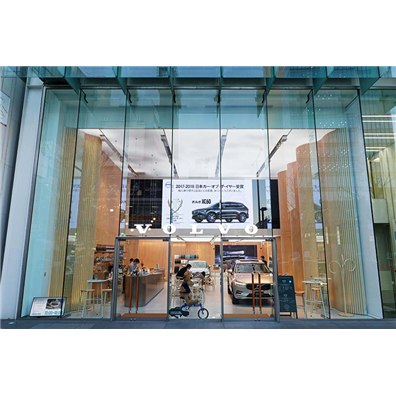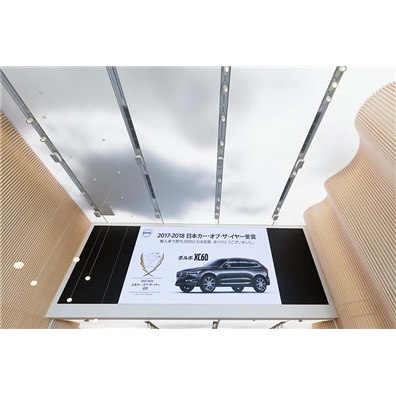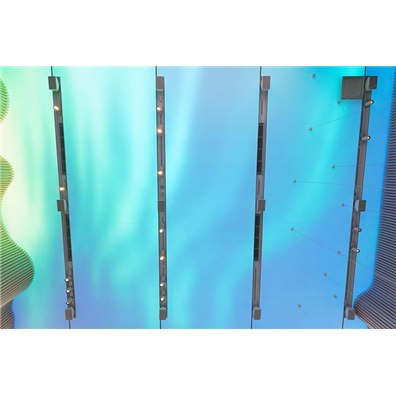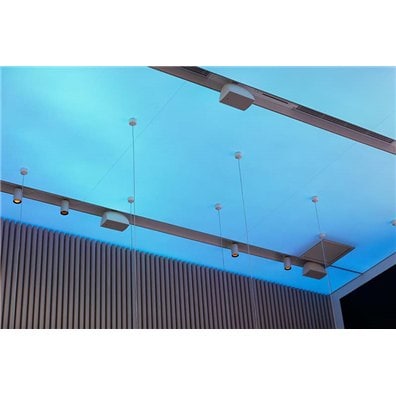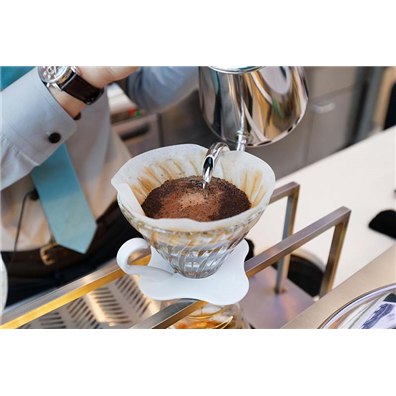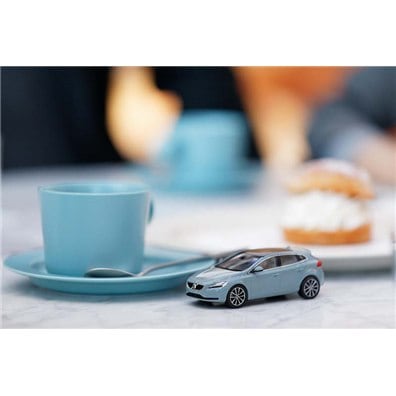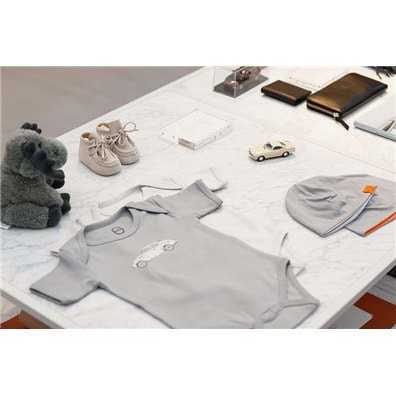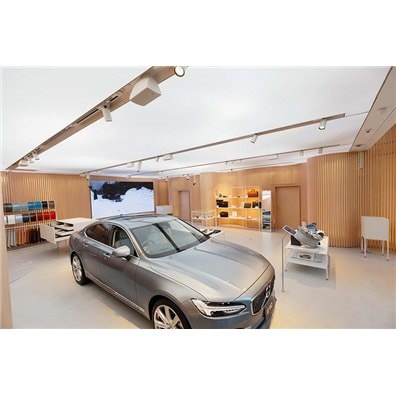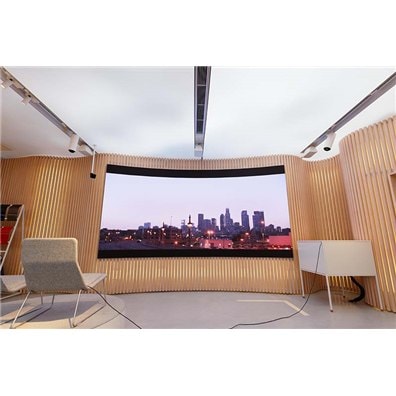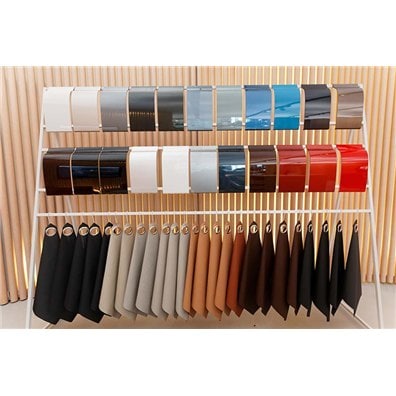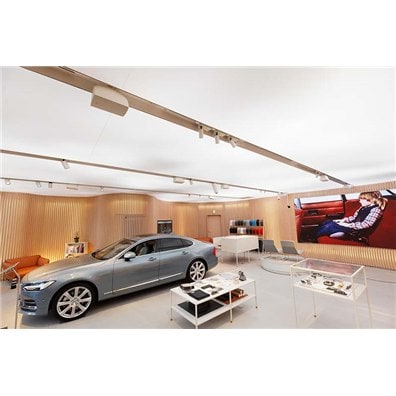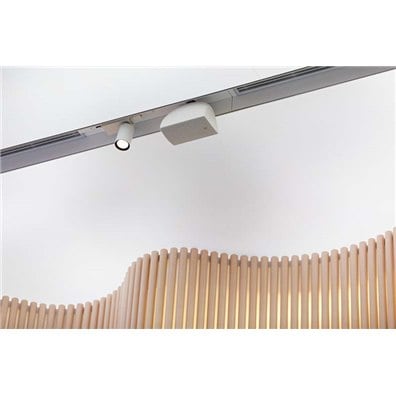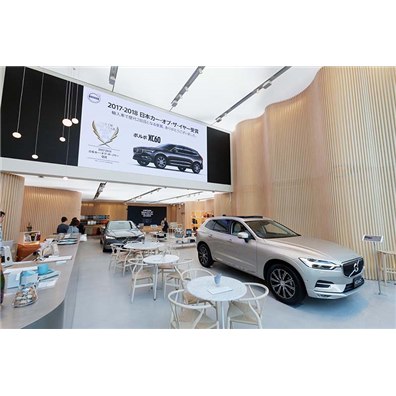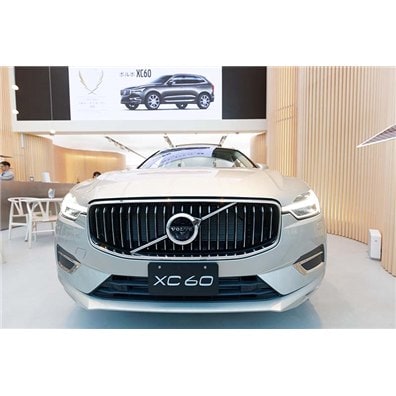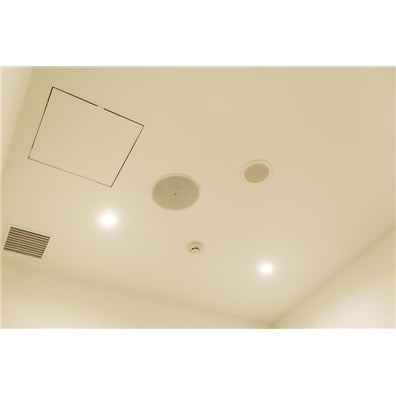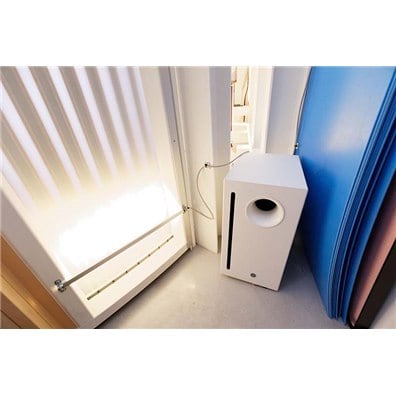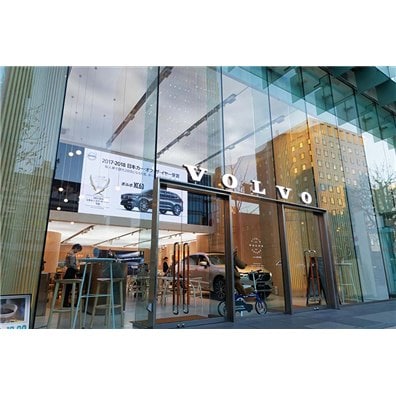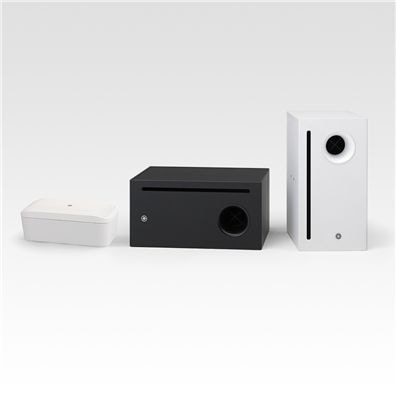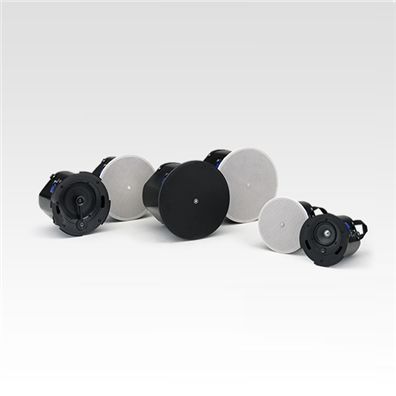Volvo Studio Aoyama by Volvo Car Japan Limited
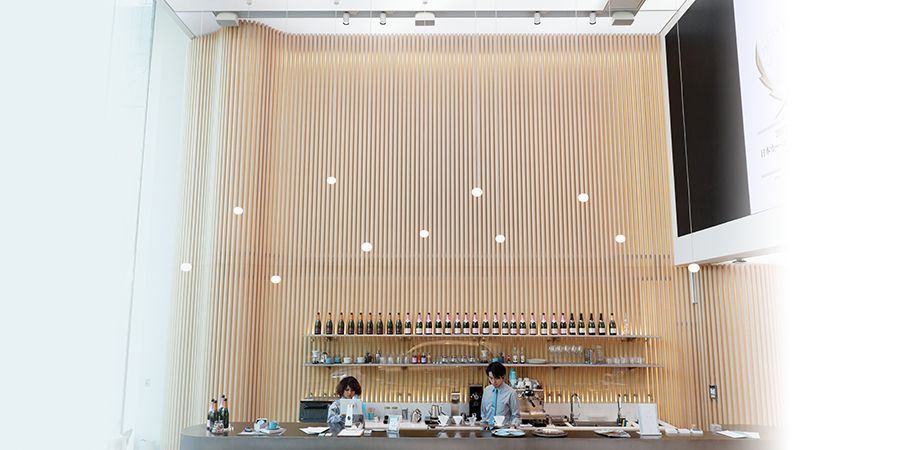
There are currently just two Volvo “Downtown Stores” (brand concept stores) in the world; the first in Milan, Italy, and the second in Aoyama, Tokyo, opened in October 2017. Volvo Studio Aoyama features a café and hosts a variety of events designed to introduce Swedish culture and the Volvo brand philosophy to a wider audience. Yamaha VXS5W speakers and VXS10SW subwoofers were chosen for the sound system in this innovative concept store. We asked Mr. Noriyoshi Sekiguchi, director of Marketing Department at Volvo Car Japan Limited, and Ms. Keiko Sano, Studio director at Volvo Studio Aoyama about the store concept. Mr. Hideki Takayama, producer with Visual Solution Department at TAKENAKA Co Ltd, provided some technical details behind the decision to use Yamaha speakers.
Volvo Studio Aoyama is one of just two Volvo concept stores. How is it different from other Volvo showrooms?
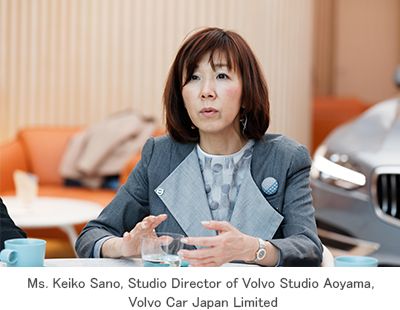
Ms. Sano:
A Volvo Studio is not simply a place where cars are displayed. It is a space where guests can learn about the Volvo brand concept and experience our broader world view. The overall design is simple and modern, typical of Sweden, Volvo’s home country. We offer unique services and “premium time” that guests can enjoy to their heart’s content.
The space is simple, but it has an overall sense of quality and beauty.
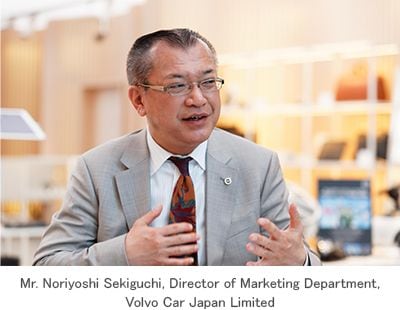
Mr. Sekiguchi:
Thank you. The Volvo Studio is a very important place for our brand. The first Volvo Studio was established in Milan, the world’s fashion capital, and the second right here in Aoyama.
Why was Aoyama chosen as the location for the second Volvo Studio?

Mr. Sekiguchi:
Many people in Japan associate Volvo with safety and reliability. We want to emphasize that it is also a premium brand with sophisticated, innovative and fashionable attributes. We felt that Aoyama, a recognized fashion center, would be an ideal place to display Volvo quality and luxury, as well as the human-centric philosophy that is at the core of Volvo design and manufacture. We’d also like people to experience Scandinavian culture.
The Scandinavian interior design is beautiful.
Ms. Sano:
Volvo Studio Aoyama is based on a design concept that is completely different from standard Volvo showrooms. The ceiling, walls, and floor are all designed to reflect Sweden’s natural environment. The ceiling is a display panel that shows blue sky and drifting clouds. On weekends, at around 9 PM during “bar time,” the ceiling comes alive with aurora borealis. The walls are composed of natural wood poles arranged to create a forest atmosphere. The floor is a special material that has been designed to resemble a rocky reef. The Volvo head office is in Göteborg, the second-largest city in Sweden, located on the country’s west coast. Our floor is designed to resemble the local reef.
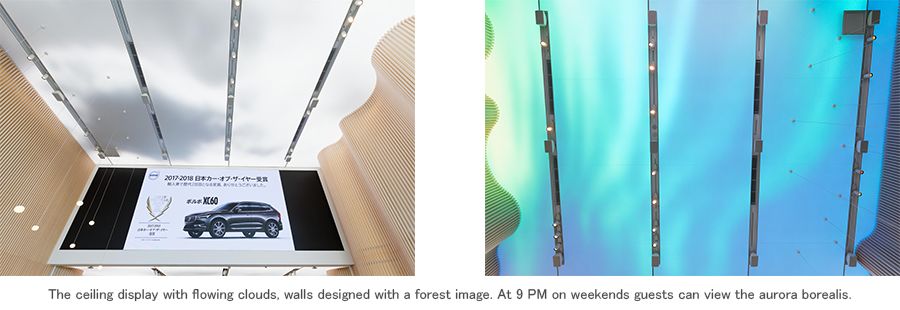
Mr. Sekiguchi:
The fact that Volvo Studio Aoyama includes a café and bar also separates it from standard car showrooms. The café operates until 6 PM, and then it becomes a champagne bar. The café serves coffee produced in collaboration with Kanno Coffee that has been carefully blended to suit Japanese taste. We also serve traditional Swedish “semla” sweet rolls.
Ms. Sano:
In Sweden there is a café culture known as “fika,” where coffee is often enjoyed with traditional Swedish sweets. I had that experience myself when visiting the Volvo head office in Sweden. People would simply say “fika!” when it was time for a break. It is similar to the afternoon “oyatsu” break we often enjoy here in Japan. We hope people will join us for fika here at the Volvo Studio.

A Swedish experience right in the middle of Aoyama!

Ms. Sano:
In Sweden, Volvo’s origin, quality of life is valued above all, and “the people” are given top priority. We hope to be able to introduce that Scandinavian lifestyle here at Volvo Studio Aoyama, and show how closely it relates to the design and manufacture of Volvo cars.
Mr. Sekiguchi:
The Studio also hosts weekly events and workshops designed to spread cultural understanding. It is our goal to introduce Volvo to new customers through music, art, and other cultural activities.
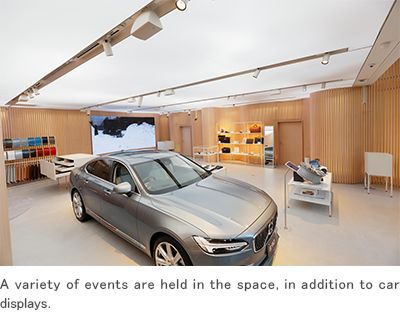
Ms. Sano:
Our cultural activities fall into four main categories. Based on a “Quality of Time” theme, we hold acoustic live and performance events featuring distinguished artists in the evening. Those events are appropriately titled “8 PM.” Then there’s the Bijutsu Techo x Volvo Art Project produced by contemporary art magazine Bijutsu Techo, with displays and performances by innovative artists. Eminent thinkers and intellectuals are invited to “Genron Café” talk sessions produced by writer and philosopher Mr. Hiroki Azuma. And we host workshops that highlight fika and other aspects of Swedish culture and craftsmanship.

Mr. Sekiguchi:
Also there is an advanced digital VR (Virtual Reality) system that allows customers to choose Volvo car body colors as well as to experience safety features.
Ms. Sano:
We can only display two cars at a time in this space, so the virtual reality system with its VR goggles and headphones is very useful. Customers can see how the cars look in other colors, sit inside and drive the cars, and even have some surprising experiences that demonstrate safety features. The car might stop automatically when moose suddenly runs in front of it, for example. Innovation is also an important part of the Volvo philosophy, as exemplified by the many digital devices available here at the Volvo Studio.
Thank you very much! Now we’ll spend some time learning the sound system with Mr. Takayama of the TAKENAKA Co Ltd. What aspects of the system did you handle for this installation?
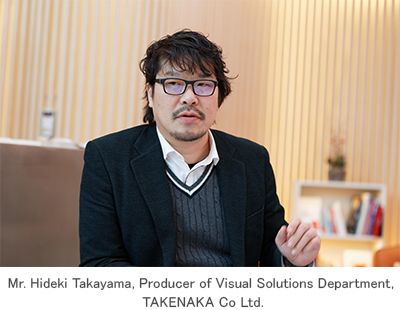
Mr. Takayama:
Our company did the visual and audio installation for Volvo Studio Aoyama. Planning and design were all done at the Volvo head office. It was our job to install the video and audio system based on the plans provided by Volvo.
It sounds like the installation did not go entirely according to plan.
Mr. Takayama:
That’s right. Japanese fire law requires emergency equipment, smoke detectors, and other facilities that the original Volvo plan did not take into account.
Can you give us some examples?
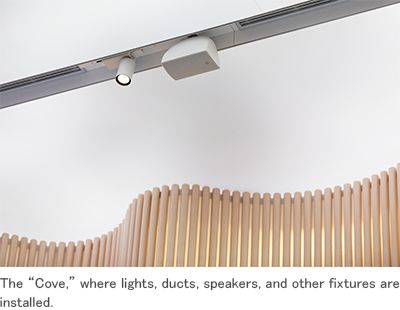
Mr. Takayama:
The Volvo plan specified electrical fixtures, lights, ducts, speakers, and anything else to be hidden in the grooves they referred to as the “Cove,” in order not to block the ceiling display panel. But the speakers from a different manufacturer that had been originally specified by Volvo did not fit in the Coves when they were laid out with emergency equipment required by Japanese fire law. At that point discussions with the Volvo head office let to the adoption of Yamaha VXS5W speakers.
What Yamaha equipment is now installed at Volvo Studio Aoyama?
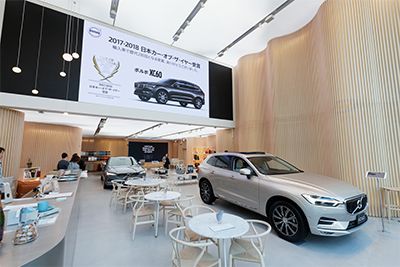
Mr. Takayama:
A total of 21 Yamaha VXS5W speakers are installed in the ceiling, assigned to three zones: entrance, a row in front of the video monitor, and the rear area. This allows optimum volume to be set for each zone. The speakers in front of the large monitor deliver sound for video content shown, while the others handle background music. Two VXS10SW subwoofers are also installed in locations that are not visible to guests. Five VXC4W ceiling speakers are installed in the office and restroom.

Can you tell us why you recommended Yamaha speakers?
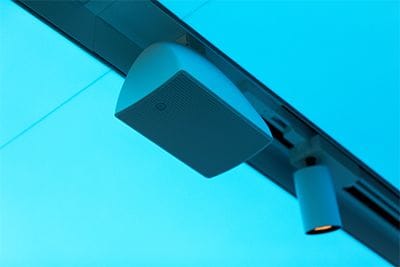
Mr. Takayama:
Design was the first consideration. Visual aspects take priority in a showroom type situation. We also compared sound with the originally specified model. The Yamaha products were more than capable of handling the task, and at a very reasonable price. The Volvo head office was impressed by the reasonable cost, but was initially worried about how the speakers would perform. When staff came from Sweden for a final inspection, their satisfaction was clearly expressed in the comment “nice sound!” The Swedish designers were very happy with the visual design, too.
How is day-to-day background music selection managed?

Mr. Sekiguchi:
Spotify, also a Swedish company, provides the music streaming service with a dedicated Volvo Studio playlist. The background music is linked to the sky video playing on the ceiling display panel.
Mr. Takayama:
The video content, mostly Swedish scenery, is sent from the Volvo head office. Different video content will sometimes be used during live performances and art events.
Thank you, Mr. Takayama. We’d like to ask Mr. Sekiguchi and Ms. Sano how they like the Yamaha speakers, now that they have been in operation for a while.
Mr. Sekiguchi:
Since this is a showroom that emphasizes our brand philosophy, design is of the utmost importance. Yamaha is known in the audio world for its sophisticated design, so I had no issues with the decision. In fact, the speakers chosen are an excellent match for this space. Their audio performance is outstanding, too.
Ms. Sano:
I feel the same way. I am very pleased with the performance of the Yamaha speakers.
Has there been any response from customers?
Ms. Sano:
Customers often comment on what a wonderful space this is. The café has a number of regular customers. There are some fashionable women who drop by every day. Too much focus on design can result in an awkward environment, but that is not the case here. We are always delighted to hear comments about what a comfortable place Volvo Studio Aoyama is. I’m sure the quality of the sound system contributes to that impression.
Thank you for your time!
Photos
Related Products
Location
Tokyo, Japan




